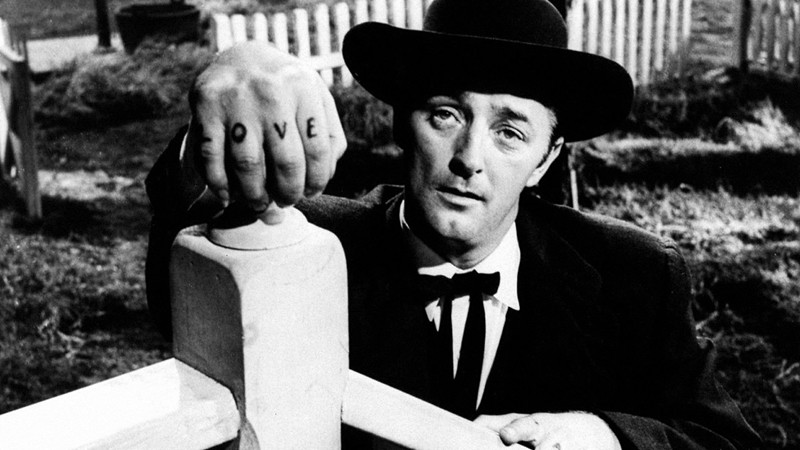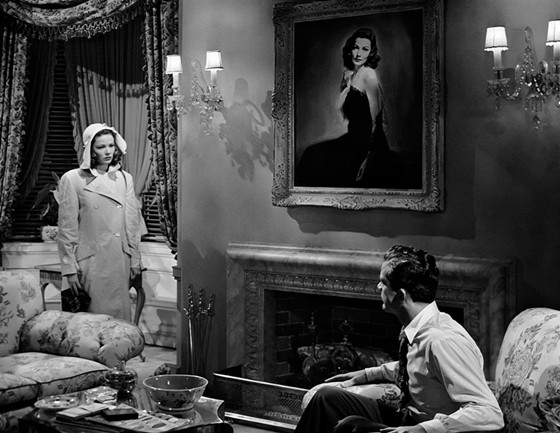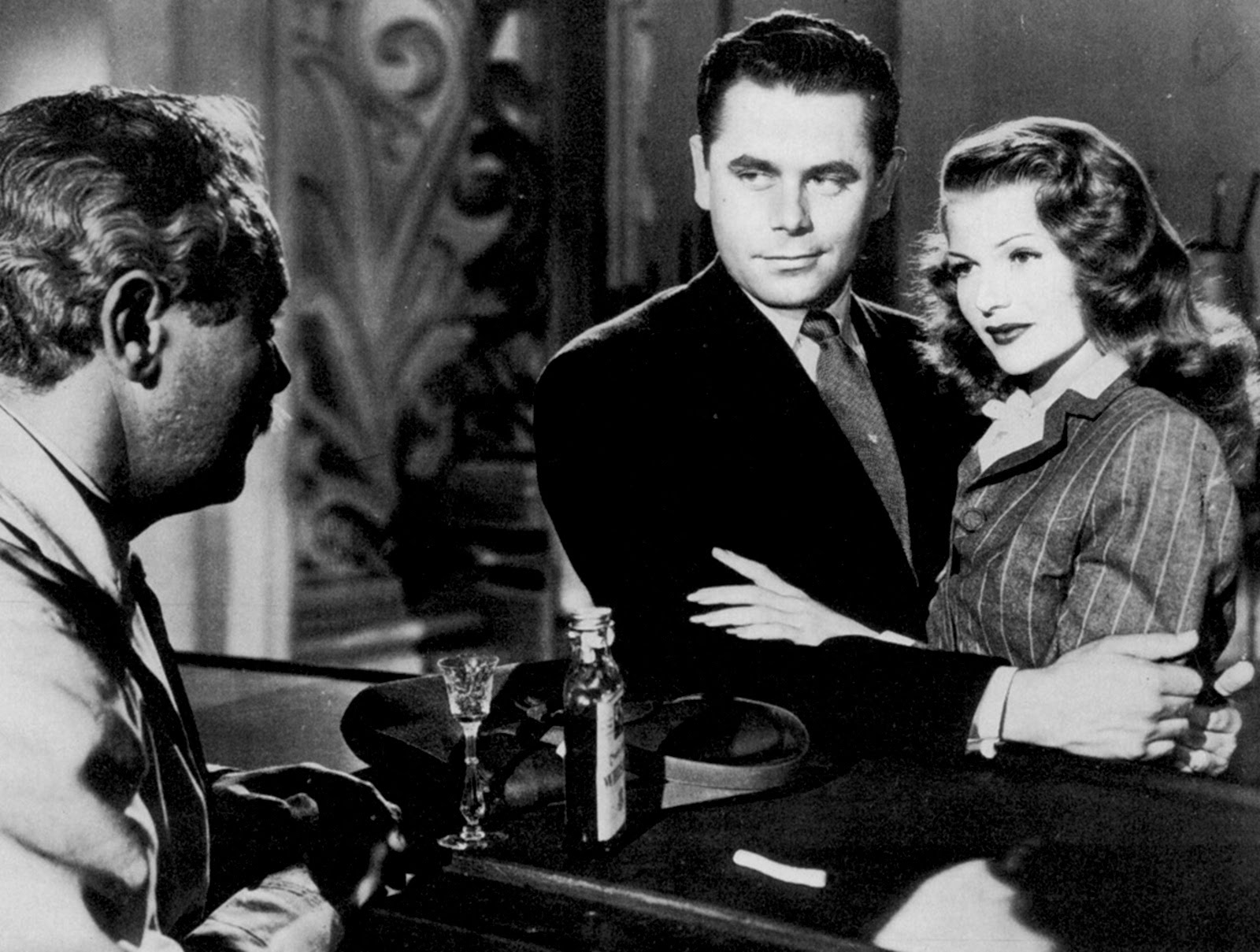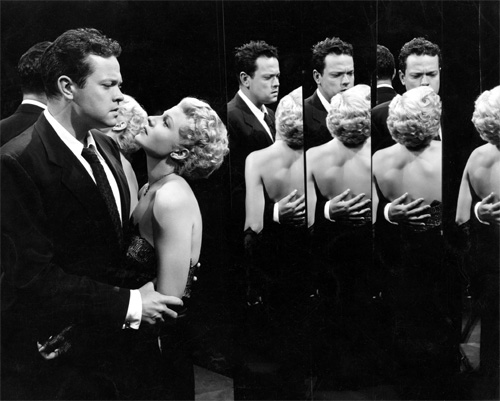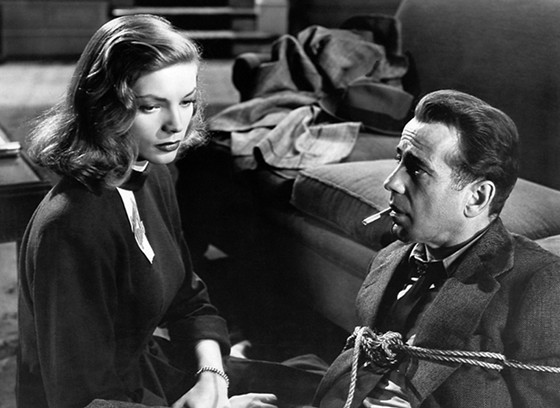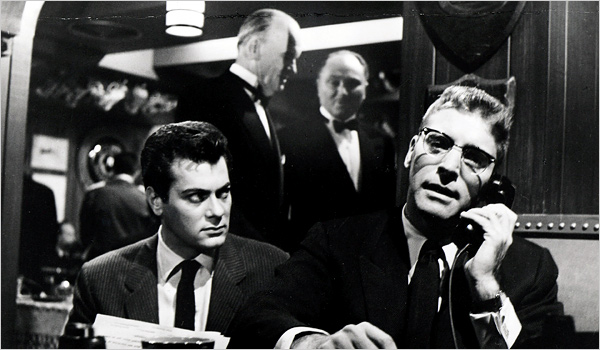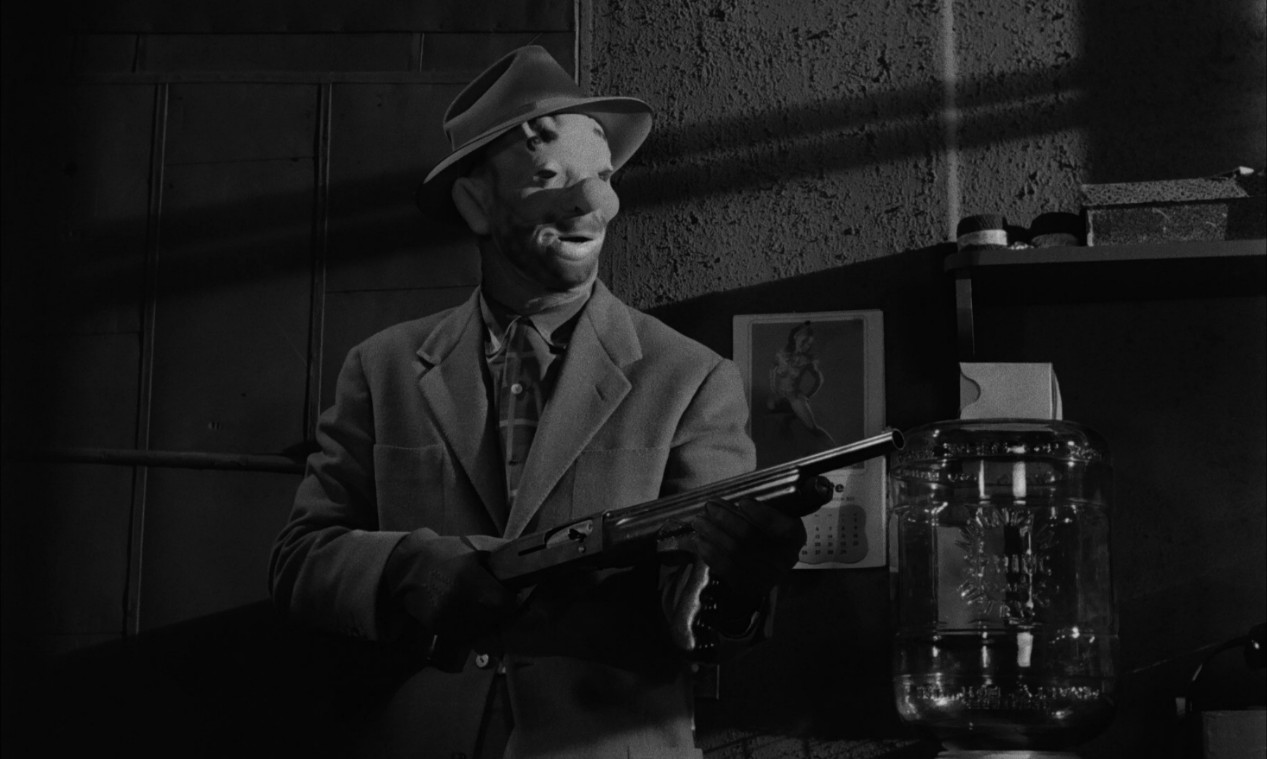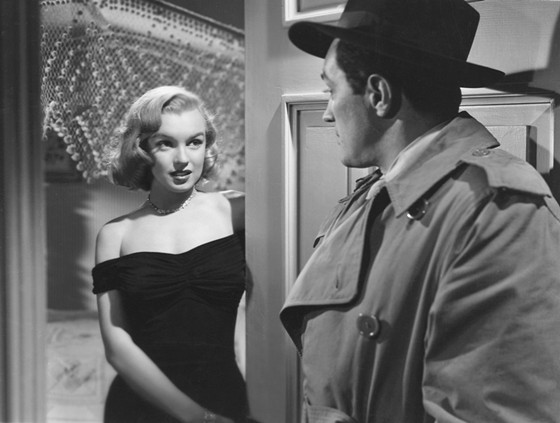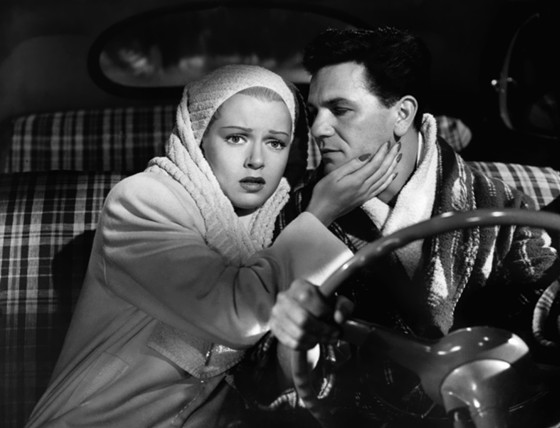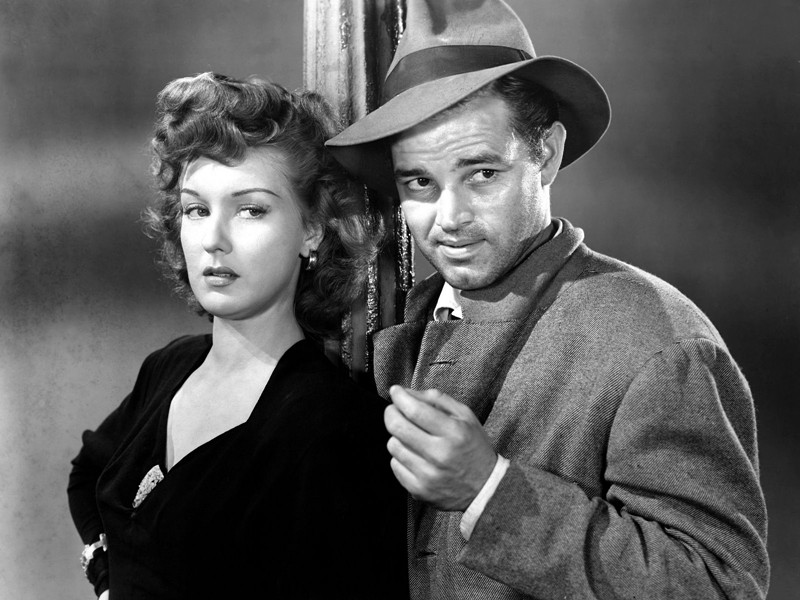20. Night of the Hunter (1955)
One of the most interesting films of the decade, Night of the Hunter is notable as the only film directed by the great English actor Charles Laughton. Robert Mitchum plays an unusual part as reverend Harry Powell, a serial killer and self appointed preacher who marries and then kills women.
Powell meets Ben Harper in prison; Harper has robbed a bank and stashed the loot in his daughter’s rag doll. Harper is executed and once Powell is out of prison he proceeds to woo Willa (Shelly Winters), Harper’s widow so that he can find the money hidden by Harper.
One of the most interesting, complex and visually expressionistic film noir, Night of the Hunter was a failure at the box office and Laughton never directed another film again. But the movie has gained a considerable reputation, particularly amongst directors such as David Lynch and Martin Scorsese, who are on the record as admiring the film.
19. Laura (1944)
Of all the women of film noir, Gene Tierney was perhaps the most alluring, and the 1944 film Laura, directed by Otto Preminger, is a great vehicle for her talents. Like The Woman in the Window, Laura features a protagonist under the spell of a beautiful women in a portrait; in this case it is Police Detective Mark McPherson (Dana Andrews).
The portrait is of Laura (Tierney), a beautiful advertising executive. McPherson is investigating her brutal murder, which includes suspects Waldo Lydecker (Clifton Webb), Laura’s mentor, her on again-off again fiancee Shelby Carpenter (Vincent Price) and Laura’s Aunt, Ann Treadwell (Judith Anderson), who appears to have an unusual interest in Shelby.
As McPherson investigates the crime and questions the suspects, he becomes more and more obsessed with Laura until Waldo accuses him of falling in love with the dead woman. One night in Laura’s apartment, McPherson drinks himself into a stupor while looking at Laura’s portrait only to fall asleep and wake up to…surprise! Well, you’ll have to see it yourself, but suffice it to say that Laura has as many twists and turns as most of the film noir of the period, and perhaps a few more.
As in many film noir, the beginning of the film is told in flashback, with voice over by Webb’s Waldo Lydecker in this case. Produced at Twentieth Century Fox and shot in beautiful black and white by Preminger, another German emigre and one of the masters of the genre, Laura was based on a novel by Vera Caspary and was transformed from what might have been a run of the mill detective film into a true classic.
18. Gilda (1946)
The definitive film of one of the definitive actresses of the classic noir period, Gilda stars Glenn Ford as Johnny Farrell and Rita Hayworth as the title character. As in many film noir, Farrell narrates the story in voice over from the time he arrives in Argentina, a small time gamble and casino cheat, and eventually hooks up with casino owner Ballin Mundson (played by the creepy George McCready as one of noir’s best ever bad guys).
Johnny becomes Mundson’s right hand man, but their relationship is strained when Mundson returns from a trip with a beautiful young wife, Gilda, whom Farrell has known in the past and purports to despise. But when Mundson double crosses some Germans running a secret cartel, he fakes his own death and disappears.
Johnny and Gilda end up marrying despite the fact that they appear to hate each other; at one point, Gilda performs a sexy strip tease to the song “Put the Blame on Mame, Boys” in order to infuriate Johnny, and it became one of the film’s iconic moments. I won’t give up more of the plot, but suffice it to say that Gilda, with its sense of brooding hatred, distrust of beautiful woman and double crossing of friends and associates, has all of the elements of a classic film noir.
Directed by Hollywood veteran King Vidor, Gilda was photographed by Polish born Rudolph Matte, who himself would go on to direct D.O.A., one of the 1950’s best film noir.
17. The Lady from Shanghai (1948)
Orson Welles was given the chance to direct again after his falling out at RKO and he produced The Stranger (1946), a solid film noir that starred Edward G. Robinson and Loretta Young. When The Stranger was a box office success, Harry Cohn gave Welles a chance to direct his wife, Rita Hayworth, in The Lady from Shanghai, and Welles produced one of the most unique and interesting film noir, albeit one with an incredibly convoluted and complicated plot.
Welles is ‘Irish’ Mike O’Hara, a sailor who meets beautiful Elsa Bannister (Rita Hayworth) in New York and, attracted to her, agrees to sign on as a hand on the yacht that she is sailing around the world on with her husband, famed lawyer Arthur Bannister (Everett Sloane). In Acapulco, the group is joined by Arthur Grisby (Glenn Anders), Bannister’s law partner, who convinces Michael to go along with him in a plot to fake Grisby’s death when they get to San Francisco.
The plan seems to have worked except for the interference of a private investigator, Broome, who is killed at the Bannister home, and eventually Grisby ends up dead and Michael is accused of his murder. Bannister serves as his attorney but, suspecting Michael is in love with his wife, has decided to lose the case.
Michael escapes from the courthouse and into San Francisco’s Chinatown where Elsa appears, ostensibly to help him in his escape. Michael, Elsa and Bannister end up in an amusement park ‘hall of mirrors’ for a final shootout and it became one of the most well known sequences in American film. Welles used images of shattering glass and distorted mirrors to reflect the tragic, destructive relationships between the three characters.
The Lady from Shanghai was inimitably Welles, but Harry Cohn hated Welles’ visual style and intricate plot, reshooting and recutting the film to an early box office grave. Still, The Lady from Shanghai has survived as a triumph of Welles rare vision, and is one of the most stylistic and unique film noir of all time.
As with most of the films of this era, the story is told by Welles in flashback with a voice over. Welles dyed his wife’s red hair blonde for the film and her mysterious portrayal of Elsa has become one of the best known femme fatale of film noir.
16. The Big Sleep (1946)
Humphrey Bogart was the biggest star in Hollywood of the 1940’s and was featured in some of the best and well known film noir, including this film. Bogart is Phillip Marlowe, private detective character of hard boiled writer Raymond Chandler, and here he is paired with Lauren Bacall. The Bogart-Bacall off screen romance was well known and shortly after they appeared together in To Have and Have Not in 1944, Bogart divorced his wife and married Bacall.
On screen, the two generated such great chemistry in To Have and Have Not that Bacall’s part in the Big Sleep was expanded and re-written to give her more scenes with Bogey. Marlowe is summoned to the home of General Sternwood and asked to resolve a situation in which his young daughter Carmen (Martha Vickers) has come to owe bookseller Geiger $15,000 in gambling debts; Sternwood’s older daughter, Vivian Rutledge (Bacall) tells Marlowe that her father actually wants him to find her father’s young friend, Sean Regan, who has recently disappeared.
Marlowe follows Geiger from his bookstore to his home where he hears a shot and on breaking in finds Geiger dead and the partially nude Carmen drugged and incoherent. A hidden camera has been taking pictures of Carmen and the next day Vivian comes to Marlowe with the pictures, saying she is now being blackmailed. Marlowe finds that the Sternwood daughters are also involved with casino owner Eddie Mars, and Marlowe learns that Sean Regan may have run off with Mars’ wife.
The complex plot is eventually resolved and the hard boiled detective, Marlowe, comes out in the clear. The Big Sleep was a huge success and cemented the Bogart-Bacall partnership, on screen and off. Directed by veteran filmmaker Howard Hawks, The Big Sleep is the best known of the screen versions of Chandler’s Phillip Marlowe books, which also included Farewell, My Lovely, The Lady in the Lake and the Long Goodbye. It was remade in 1978 with Robert Mitchum as Marlowe.
15. Sweet Smell of Success (1957)
As the 1950’s wore on, film noir expanded stylistically in ways that would have been unheard of a decade earlier. A great example of this is Sweet Smell of Success, featuring Tony Curtis as Sidney Falco, a theatrical agent who will do anything to place an item in the column of powerful columnist JJ Hunsecker (Burt Lancaster).
Hunsecker wants to break up his sister’s relationship with jazz musician Steve Dallas (Martin Milner) and pressures Falco into having an item planted in a rival column that Dallas is a pot smoking commie. The plan seems to work until Dallas confronts JJ and insults him; the columnist then forces Falco to actually frame the musician with drugs.
Shot on location in the mean streets of New York by British director Alexander Mackendrick and based on a short novel by Ernest Lehman, Sweet Smell of Success proved too harsh for 1950’s audiences and failed at the box office (sense a trend here?) but the film’s cynical, unrelentingly harsh vision proved more acceptable to audiences over time, and the film is now regarded as a classic. Barry Levinson paid homage to the film in his own Diner (1982) by having one character do nothing but walk around quoting lines from the film. If you’re going to quote from a movie, it might as well be this one, right Sidney?
14. The Killing (1956)
Young director Stanley Kubrick got his first opportunity to make a Hollywood feature with The Killing, when partner James B. Harris purchased the rights to Lionel White’s novel. Kubrick authored the screenplay with hard boiled writer Jim Thompson. The story is about a heist headed by Johnny Clay (Sterling Hayden) who assembles a team in order to rob the money counting room of a horse racetrack during a big race. T
he most notable element of The Killing is the non-linear style of storytelling that Kubrick employed, as the audience gets the details of the big heist from the character’s various points of view. This style was a big influence on later directors, most notably Quentin Tarantino, who utilized this technique in his breakthrough 1992 film Reservoir Dogs.
The Killing was a box office failure on its initial release, but was critically praised and Kubrick went on to make his signature early film, Paths of Glory, a year later. The Killing features a great cast including Hadyen, Elisha Cook, Jr., Ted de Corsia, Marie Windsor and Vince Evans as the thief who tries to steal from the crooks.
13. The Asphalt Jungle (1950)
Another caper film noir featuring Sterling Hayden is the Asphalt Jungle, directed by regular noir director John Huston. Co-starring Sam Jaffe as “Doc” Riedenschneider, the Asphalt Jungle is the story of jewel heist masterminded by Doc after his release from prison. His team included Dix Handley (Hayden) who wants to use the money to buy back the Kentucky horse farm lost by his father.
The operation is financed by crooked lawyer Alonzo Emmerich (Louis Calhern) who says that he will pay the robbers and fence the jewelry himself; Emmerich, however, has a double cross planned. The jewel robbery succeeds, but one of the robbers is accidentally shot by a security guard during the heist. Finally, Doc and Dix figure out that the lawyer does not have their best interests at heart and the entire plan begins to fall apart.
The Asphalt Jungle is notable for an early appearance by Fox contract girl Marilyn Monroe as the young girlfriend of Emmerich, and for the contradiction between the harsh, urban ‘asphalt jungle’ that Dix and his cohorts inhabit and the beautiful, rural horse farm to which he dreams of returning. Dix makes it in the end, but as a typical noir protagonist, his future seems bleak.
The Asphalt Jungle is a typical strong effort of John Huston, who directed the first (The Maltese Falcon) and many other fine film noir over the years.
12. The Postman Always Rings Twice (1946)
MGM was a glamour studio and did not make many film noir, instead concentrating more on romance films and musicals, but they produced one of the best in 1946 with the Lana Turner-John Garfield vehicle The Postman Always Rings Twice. Garfield is Frank Chambers, a drifter who shows up at the roadside diner owned by Cora Smith (Turner) and her much older husband Nick (Cecil Kellaway).
There is instant sexual tension between Cora and Frank, but Nick does not seem aware of it and hires Frank on to help around the diner. Soon Frank is helping himself to Cora and the two plan to get rid of Nick and grab the diner for themselves via the usual noir way: murder. Their first attempt fails, but the second attempt succeeds when they bludgeon the inebriated Nick and send him over a cliff in his car.
D.A. Kyle Sackett (Leon Ames) suspects the couple in the murder and eventually tries to get them to turn on each other. Neither Frank nor Cora fully trust the other, and Sackett tries a clever ploy to get the truth out of Cora but Cora’s clever lawyer, Arthur Keats, ends up getting his client off with a manslaughter charge and probation. Cora and Frank return to the diner where they eventually end up marrying, but they don’t trust each other and the relationship is uneasy. Finally, just as it appears Frank and Cora will find happiness, it is snatched away from them by cruel fate.
The Postman Always Rings Twice was reminiscent of Double Indemnity in the sense that a situation of high sexual tension leads to murder. The resulting distrust and suspicion put the characters under a cloud that they cannot escape from, and eventually their fate is sealed and their relationship doomed.
In the world of film noir, sexual tension almost always leads to a bad end, and nowhere is that more evident than in The Postman Always Rings Twice. The film was remade in 1981 with Jack Nicholson and Jessica Lange, but was a critical and commercial failure.
11. Detour (1945)
The other films on this list were all made at big studios with “A” stars, but Detour is unusual as it was a low budget film featuring the relatively unknown Tom Neal as Al Roberts and Ann Savage as Vera. The film was directed by Austrian Edgar Ulmer, another veteran of the German film industry of the 1920’s, and was shot on a quick schedule and low budget.
The film begins with Al Roberts telling his story in flashback at a roadside diner. Roberts is a jazz musician living in New York who has a falling out with his girlfriend. When she leaves to go to Hollywood to seek fame and fortune, Roberts goes after her but having little money has to hitch-hike. He is picked up by pill popping Charles Haskell who dies during a night of driving; nervous Al decides instead of telling the police and risking being accused of murder, he is better off taking Haskell’s car, money and identity.
His mistake comes when he picks up a hitch-hiker, the oily Vera, who earlier had been given a ride by Haskell and fought off his advances. Knowing that Al is not Haskell, Vera blackmails him and the two enter into a bitter relationship of distrust and hatred. The situation turns grave for Al when they arrive in L.A. and Vera learns that Haskell’s wealthy father is on his death bed and decides that Al should continue impersonating Haskell so they can collect the inheritance.
Having made the fateful detour by picking up Vera and becoming ensnared in her web, Al bemoans his situation saying “Fate, or some mysterious force, can put the finger on you or me for no good reason at all.”
This may be the ultimate statement of film noir, and this gritty film whose reputation rose radically in the 1970’s and 80’s, is one of the best representations of the nightmare noir world in which an otherwise innocent man becomes enmeshed in a serious of circumstances from which he cannot disentangle himself.
Film noir did not necessarily require big stars and could be made for little money and on a tight schedule, and nowhere is that more evident than in Detour, which has finally achieved the successful reputation it deserves.
